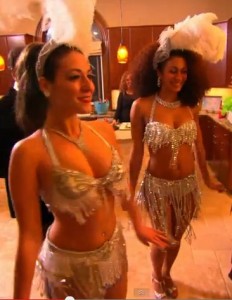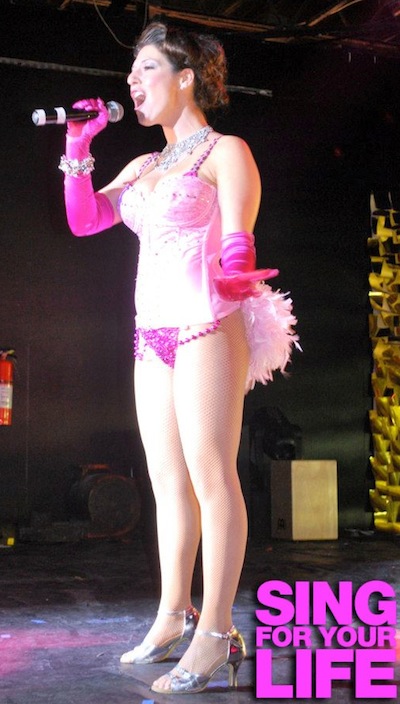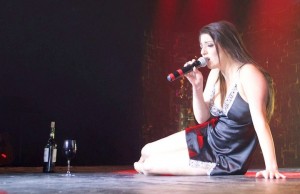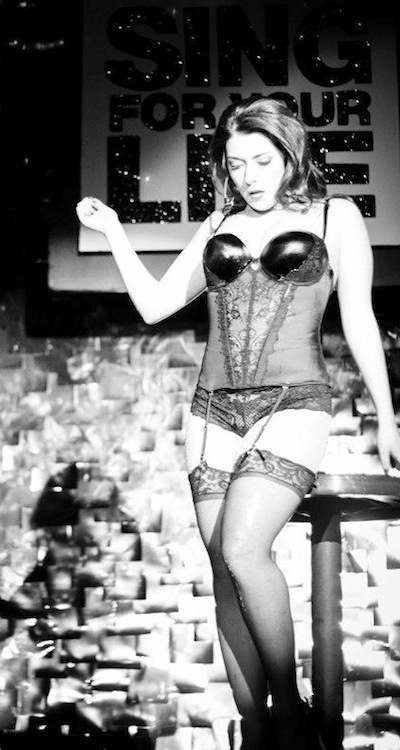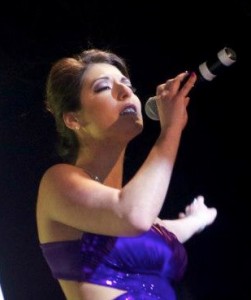by Rex Reverb,
Contributing Writer
Get entertained this Thursday, December 18, at Atlanta’s Jungle Club by our Kool Kat of the Week and one of Atlanta’s new young singers, Josette Pimenta (often just “Josette” or “Josette P”) during her and her co-headliner, Christy Clark’s Sing for Your Life performance at 8 pm! A noted dancer with several local Atlanta dance troupes (including the Dames Aflame), Josette combines cabaret, burlesque and high-energy dance with a powerful voice to create her own unique brand of entertainment. Josette will be doing at least five numbers at her upcoming show, which is part of the Sing for Your Life competition, where she’s a judge this year. Josette‘s shows are always full of surprises, and ATLRetro readers will get the chance to experience her unique rendition of Peggy Lee‘s song, “Black Coffee.” More information about the show can be found here.
For those too young to remember Peggy Lee, she might be best known today as the singing voice for Jessica Rabbit. For those who haven’t seen Josette perform, imagine Jessica Rabbit combined with Cher, along with another classic cartoon character, RED HOT RIDING HOOD from the ‘40s.
Josette’s tale is like something out of a movie. She was told as a child that she didn’t have a good voice and couldn’t sing, causing her to shy away from singing in public for almost a decade, but now suddenly has a singing career. Although Josette is only 23-years old, this diminutive dynamo brings fresh energy and excitement–and more than a touch of burlesque and cabaret–to songs ranging from retro classics to recent hits to her own compositions.
Before diving into Josette‘s story, check out her rendition of Peggy Lee’s “Coffee” here!
Josette wanted to be a performer since she was a small child. She remembers at age five, jumping on her parent’s coffee table in her underwear, putting on a show by singing at the top of her lungs like her idol, Cher. Her parents, grandmother (who’d been a vocalist with a band) and uncles filled the house with music from many eras, and Josette began a passion for retro music that continues to this day. Josette also loved to dance and becoming a singer/dancer became her main goal in life. Her supportive parents helped her begin dance lessons at age 9, but she soon faced her first obstacle.
Josette‘s ballet teacher took the youngster aside after class, and told her while it was clear she loved to dance, “you’re never going to be a dancer.” That was a hard thing for a child to hear, but she managed to get past it, and continue her dance training.
Josette never had voice lessons or vocal training, but when she was around 12, she took a class in musical theater. During one of her first classes, when all of the students were singing, the teacher singled her out, saying “Josette, can you just stop singing? You’re a lot louder than everyone else and you just don’t sound good.”
Such criticism, in front of the whole class, really stung the young Josette. She took it to mean that she didn’t have a good voice and couldn’t sing. It crushed her dream of becoming a singer/dancer like Cher, and for years afterward, she “shied away from singing.” For Josette, there was no chorus, no high school musical, no Glee Club, no singing lessons. She only sang at home with her family or close friends, or in the privacy of her own room. Instead, she focused on her dancing, working hard to pursue her scaled-down dream of becoming a (non-singing) professional dancer.
In high school, Josette experienced mostly success, but also some bullying, on the Dance Team. She was so focused on her goal of becoming a performer after high school that she really didn’t have a back-up plan. She taught dance for a year, then became a bartender, to have the flexible schedule needed for dance auditions.
She first landed a spot with Davina and the Harlots, the local burlesque group with a flair for comedy, at which Josette also excelled. Josette then auditioned for the Dames Aflame, one of America’s premiere burlesque/cabaret groups, and was thrilled to be accepted. Josette‘s first public performance with the Dames Aflame took place at Trader Vics Atlanta in August, 2011, supporting the great “Big Mike” Geier (See his Kool Kat feature here) and Tongo Hiti. The rookie Josette was joined by long-time Dames Aflame veteran Shockaboom, whose Polynesian dance performances at Trader Vic’s are legendary.
Josette wasn’t content to merely put on a good show, but worked hard to make sure that everyone had a great time. Shockaboom always goes all out for Mike’s finale, and I was surprised to see Josette keeping up with Shockaboom’s Samba-like gyrations, shake-for-shake and shimmy-for-shimmy.
Josette‘s performances with the Dames Aflame, and Davina and the Harlots, averaged only two or three per month (including a few seconds on Bravo’s MARRIED TO MEDICINE, shown in the accompanying photo). So Josette continued to audition for full-time, professional dance roles, in touring Broadway shows, cruise ship shows, and major theme parks. Sometimes, the auditions would go really well, but she would never get a call back–perhaps because Josette was only 5′ 2″, while most Broadway-type dancers are at least 5′ 7″ (the minimum height to even audition for a group like the Rockettes).
Away from those auditions, Josette gradually tried singing in public again. It had been nine years since she’d had her singing aspirations crushed, but once or twice a year she would work a comedy or novelty song into a burlesque skit, usually with a group or another singer.
By the fall of 2012, she’d sung a song in public less than a handful of times. When dared by fellow dancer Sarah Blackman to enter a new singing competition, Sing for your Life, Josette–perhaps helped by the bottle of wine they were sharing–said “sure, why not?” The next day, she realized she had less than 24-hours to pick a song, figure out how to perform it, film it and submit the tape by the contest deadline.
Josette had her mother tape her singing “Half Breed” by Cher, and gave it a comedy/novelty treatment by performing it on a rocking horse. Still plagued by doubt over her singing ability, she almost didn’t submit the tape, but finally entered at the last minute with no expectation of success. To Josette’s surprise, she made it into the contest. She performed “Valerie” by Amy Winehouse at Sing for Your Life‘s live auditions held at Atlanta’s Jungle Club. Halfway through the song, the judges told her to stop singing and summoned her to come down off the stage. Worried about what would come next, Josette was relieved when they asked her to sing a standard. Drawing on her love of retro music, she sang “Almost Like Being in Love” by Nat King Cole, and made it into the final 12 contestants.
For the first week of the 12-week long competition, she chose “Someone to Watch Over Me” by George and Ira Gershwin. Josette planned an arrangement that showed her range in the middle of the song, and even though it was cut for time at the last minute, Josette advanced to next week’s round.
Josette began hoping she might have a future as a singer. Though she lacked the vocal training or singing experience of most of the other singers, from her dozens of dance recitals, she knew how to put on a show.
Week Two’s theme was “Divas” and Josette chose the “ultimate diva,” Marilyn Monroe. Josette planned to sing “Diamonds Are a Girl’s Best Friend” in an elaborate production. She’d sing the preamble while wearing a coat, then–when the main part of the song began–she’d drop the coat to reveal a sexy, jeweled costume. Josette planned to sing all over the stage and even go down the steep stairs into the audience. Despite all her planning, a huge problem arose once she began performing the song in front of the audience in the actual competition. She was so new to singing, that she didn’t know how to make sure the microphone was turned on!
The Jungle Club is a huge, warehouse-like space, so even her powerful voice could barely be heard past the first few rows. For most of those in the audience, she was almost inaudible, and not even as loud as a phone ringing. Finally, just after Josette dropped her coat to reveal her sexy costume, a sound technician went onto the stage to turn on her microphone, but her problems weren’t over. When the song started to replay from the beginning, Josette had to break character, explaining to the DJ that she wanted to resume where the song had originally stopped. The curtain even started to close on her, before someone pulled it back. Then, more agonizing seconds ticked by, as she stood in silence on stage, while the DJ tried to re-cue her music.
Many amateurs would have panicked at that point, but Josette’s dance training made her comfortable on stage. She slipped back into character, vamping for time until the music was finally ready. Still, Josette faced a daunting task: To avoid being the contestant sent home that night. She had only two minutes left of her song to impress the audience and the judges. A lifetime of hopes and dreams came down to those two minutes.
And then it happened! She started off good, becoming very good in a few more seconds. Soon, the amateur singer was performing the song as if she were a seasoned professional who’d sung it dozens of times. With the powerful delivery of a Broadway star, Josette unleashed a decade of pent-up singing talent in an amazingly confident performance. For the final note, her voice soared, as she sang longer and with more power than she
ever had before. It was as if she was determined to give the audience and judges something to remember instead of her microphone problems. And she did! See her performance here, which blurs the line between cabaret, burlesque and Broadway.
Needless to say, Josette advanced to the competition’s next round. It was as if that final powerful note had pierced her own personal sound barrier, because from that point on, she could seemingly sing anything. Her next song was an even more elaborate production of “Roxie” from CHICAGO, complete with two back-up dancers. Josette, the young woman who’d never sung in a musical, looked like an experienced pro.
For Week Seven, she chose “Bad Romance” by Lady Gaga, rendering an even more elaborately choreographed production, again with back-up dancers. But this time, the audience voted Josette down, into the bottom two. Whatever the reason, Josette found herself Singing for her Life against the other low-rated contestant (like Josette, also an excellent singer). Josette barely survived, and advanced to the next round.
As if determined to show that she could win on her voice alone, the next week Josette sang Pink’s “Glitter in the Air” while seated. Using her body, hands and facial expressions, she still delivered an incredible vocal performance. In the coming weeks, she showed her increasing versatility (and growing confidence) by giving good performances of songs by Billy Joel, Pat Benatar and Willie Nelson.
In Week 10, she took the art of burlesque and cabaret to a new level, by singing the Billie Holiday classic “I’m A Fool to Want You” in a unique way. Not only did she not dance, she again didn’t even stand up! And near the end of the song–well, you’ll have to see for yourself. Take a peek at Josette’s rendition here.
Finally, it was down to Week 12, the final week, when Josette faced off against only one other contestant, Amber Renee. Each had to perform three songs, and for Josette‘s final song of the competition, she made a very unlikely choice: “Black Coffee” by Peggy Lee. In addition to being very obscure for most of the audience, it’s definitely a “downer” song and not an obvious crowd pleaser.
But she trusted her instincts. It was one of her favorite songs to perform alone in her room, in the not-too-distant past when she was afraid to sing in public. She always envisioned herself performing it in a sultry way, in a suitably lurid setting inspired by old movies and pulp covers she saw on the internet.
In her introduction to “Black Coffee”, the strain of the twelve grueling weeks of intense competition is evident. She knew all of her recently-revived hopes and dreams were riding on the outcome of that night’s performance. There was a cash prize, but more importantly for her, the first prize also included a producer and studio time to actually record three songs, plus a life solo show of her singing.
Josette found a way to make an obscure, downer of a song, the hit of the evening. You have to see her performance of “Black Coffee” for yourself. The effect on the audience was electric. I’ve studied burlesque for 25 years, and I’ve never seen a performance like that. Is it burlesque? Is it cabaret? I don’t know, but the audience loved it!
Still, Amber Renee was a formidable rival, and suspense filled the room as the last judge voted. When judge Barry Brandon finally announced that Josette had won the competition, she doubled over with emotion and burst into tears. Josette sobbed into the arms of her coach Michael Robinson, and she couldn’t have been more emotional or grateful if she’d won a million dollars or American Idol.
Josette told me that from the start, she hadn’t expected to win, and after three very stressful months, she couldn’t believe she’d actually prevailed. After regaining her composure, she tried to say a few words, telling the audience how she came to enter the contest. But when Josette started trying to explain about being told as a child that she couldn’t sing, she started to break down. Pulling herself together, she started to thank everyone, but broke down again. Pulling herself together again, she went out into the audience and gave a heartfelt, emotional thanks (and often a hug) to everyone she recognized or who came up to congratulate her.
Josette hadn’t just won a singing contest. She’d finally achieved the first step in a dream that had been shattered and shelved almost 10 years earlier.
But there was one final twist to her story, one that even Josette hadn’t seen coming. Impressed during the competition when a few contestants sang their own original songs, Josette wondered: Could she write her own songs as well?
Collaborating with Atlanta songwriter J. L. Rodriguez, Josette began writing her very first pop song. They worked on the musical parts together (since she doesn’t play an instrument or read music), and she wrote the lyrics, having been inspired by a drawing of cat women a fellow Harlots alum had created. Top local producer, Thomas Cary Walker Jr., pitched in and in October 2013, Josette‘s first single, “Here Kitty Kitty,” was released on iTunes.
Josette gave the first full performance of her very first song in front of 10,000 people at Piedmont Park, during Atlanta’s LGBT Pride Festival. This was a full production, with four professional backup dancers, great lighting and Josette on the huge Jumbotron screen next to the massive stage. As she admitted to the audience after the song, she was nervous when she first came out. But she quickly settled down and was soon delivering a powerhouse performance, singing and dancing all over the stage.
Remember Shockaboom‘s finale with Tongo Hiti at Trader Vics, that Josette emulated the first time she danced there for the Dames Aflame? What seemed like a Samba move to me a few years ago had another name by last fall: Twerking. On the big stage at Piedmont Park, Josette had taken what she learned from Shockaboom to a whole new level and was light-years beyond Miley Cyrus. The already-cheering crowd started to roar, and when Josette whipped her long hair around to the sound of a whip being cracked, 10,000 people went wild. Catch a video of the wild scene here!
At the end of the number, Josette paused to catch her breath and look out over the cheering crowd. Seeing 10,000 people cheering for her singing, her dancing, and her first song–less than a year after entering the singing contest–was like the improbable ending to an old Hollywood move.
While Josette is the living embodiment of Red Hot Riding Hood on stage and says she just naturally tends to dance in a sexy fashion, off stage she’s very much a down-to-earth, girl-next-door type, a kind and sensitive person. Instead of talking about becoming a star, she talks about being creative, the joy of seeing her artistic vision fulfilled, and how great she feels when she’s entertained (and surprised) an audience. Luckily, she’s got a very supportive network of people helping her, including parents, a large extended family, boyfriend, friends and fellow performers.
Josette continues to dance with the Dames Aflame, and on December 20, she’ll be performing with them as a dancer in “Big Mike” Geier’s Kingsized Holida Jubilee extravaganza at the Variety Playhouse. This past year, Josette has focused primarily on her dancing, after joining two additional dance troupes–the BELLES (from Belles Organics) and THE CHERRY BOMBS. The Cherry Bombs will be joining her for a performance at Josette‘s big December 18 show at the Jungle Club. That show marks a return to singing for the busy Josette, and she plans to get back into the recording studio in the new year.
Photos copyright 2012-2014 Whitney Fields Photography. Some have been cropped from their original appearance.


